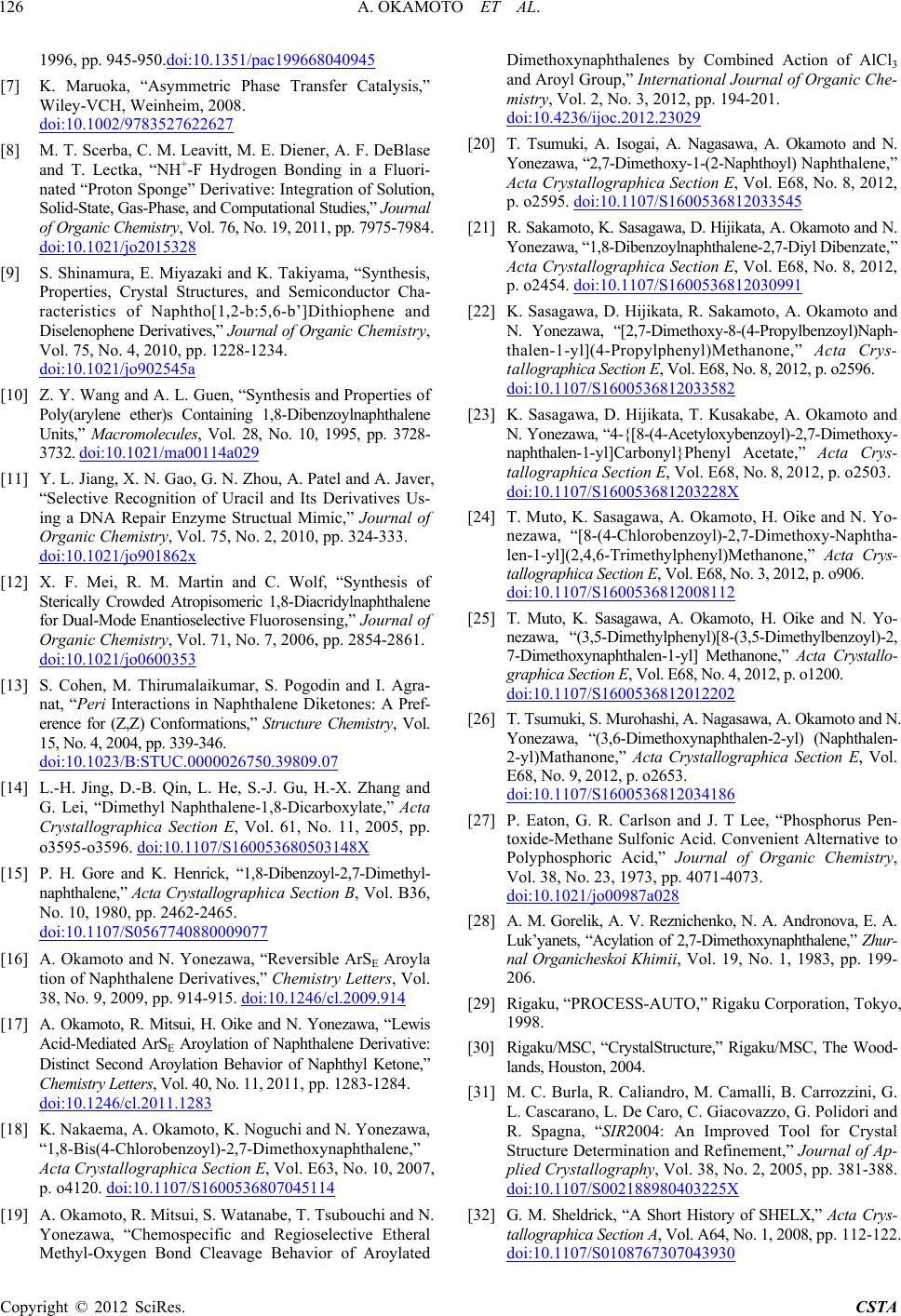
A. OKAMOTO ET AL.
126
1996, pp. 945-950.doi:10.1351/pac199668040945
[7] K. Maruoka, “Asymmetric Phase Transfer Catalysis,”
Wiley-VCH, Weinheim, 2008.
doi:10.1002/9783527622627
[8] M. T. Scerba, C. M. Leavitt, M. E. Diener, A. F. DeBlase
and T. Lectka, “NH+-F Hydrogen Bonding in a Fluori-
nated “Proton Sponge” Derivative: Integration of Solution,
Solid-State, Gas-Phase, and Computational Studies,” Journal
of Organic Chemistry, Vol. 76, No. 19, 2011, pp. 7975-7984.
doi:10.1021/jo2015328
[9] S. Shinamura, E. Miyazaki and K. Takiyama, “Synthesis,
Properties, Crystal Structures, and Semiconductor Cha-
racteristics of Naphtho[1,2-b:5,6-b’]Dithiophene and
Diselenophene Derivatives,” Journal of Organic Chemistry,
Vol. 75, No. 4, 2010, pp. 1228-1234.
doi:10.1021/jo902545a
[10] Z. Y. Wang and A. L. Guen, “Synthesis and Properties of
Poly(arylene ether)s Containing 1,8-Dibenzoylnaphthalene
Units,” Macromolecules, Vol. 28, No. 10, 1995, pp. 3728-
3732. doi:10.1021/ma00114a029
[11] Y. L. Jiang, X. N. Gao, G. N. Zhou, A. Patel and A. Javer,
“Selective Recognition of Uracil and Its Derivatives Us-
ing a DNA Repair Enzyme Structual Mimic,” Journal of
Organic Chemistry, Vol. 75, No. 2, 2010, pp. 324-333.
doi:10.1021/jo901862x
[12] X. F. Mei, R. M. Martin and C. Wolf, “Synthesis of
Sterically Crowded Atropisomeric 1,8-Diacridylnaphthalene
for Dual-Mode Enantioselective Fluorosensing,” Journal of
Organic Chemistry, Vol. 71, No. 7, 2006, pp. 2854-2861.
doi:10.1021/jo0600353
[13] S. Cohen, M. Thirumalaikumar, S. Pogodin and I. Agra-
nat, “Peri Interactions in Naphthalene Diketones: A Pref-
erence for (Z,Z) Conformations,” Structure Chemistry, Vol.
15, No. 4, 2004, pp. 339-346.
doi:10.1023/B:STUC.0000026750.39809.07
[14] L.-H. Jing, D.-B. Qin, L. He, S.-J. Gu, H.-X. Zhang and
G. Lei, “Dimethyl Naphthalene-1,8-Dicarboxylate,” Acta
Crystallographica Section E, Vol. 61, No. 11, 2005, pp.
o3595-o3596. doi:10.1107/S160053680503148X
[15] P. H. Gore and K. Henrick, “1,8-Dibenzoyl-2,7-Dimethyl-
naphthalene,” Acta Crystallographica Section B, Vol. B36,
No. 10, 1980, pp. 2462-2465.
doi:10.1107/S0567740880009077
[16] A. Okamoto and N. Yonezawa, “Reversible ArSE Aroyla
tion of Naphthalene Derivatives,” Chemistry Letters, Vol.
38, No. 9, 2009, pp. 914-915. doi:10.1246/cl.2009.914
[17] A. Okamoto, R. Mitsui, H. Oike and N. Yonezawa, “Lewis
Acid-Mediated ArSE Aroylation of Naphthalene Derivative:
Distinct Second Aroylation Behavior of Naphthyl Ketone,”
Chemistry Letters, Vol. 40, No. 11, 2011, pp. 1283-1284.
doi:10.1246/cl.2011.1283
[18] K. Nakaema, A. Okamoto, K. Noguchi and N. Yonezawa,
“1,8-Bis(4-Chlorobenzoyl)-2,7-Dimethoxynaphthalene,”
Acta Crystallographica Section E, Vol. E63, No. 10, 2007,
p. o4120. doi:10.1107/S1600536807045114
[19] A. Okamoto, R. Mitsui, S. Watanabe, T. Tsubouchi and N.
Yonezawa, “Chemospecific and Regioselective Etheral
Methyl-Oxygen Bond Cleavage Behavior of Aroylated
Dimethoxynaphthalenes by Combined Action of AlCl3
and Aroyl Group,” International Journal of Organic Che-
mistry, Vol. 2, No. 3, 2012, pp. 194-201.
doi:10.4236/ijoc.2012.23029
[20] T. Tsumuki, A. Isogai, A. Nagasawa, A. Okamoto and N.
Yonezawa, “2,7-Dimethoxy-1-(2-Naphthoyl) Naphthalene,”
Acta Crystallographica Section E, Vol. E68, No. 8, 2012,
p. o2595. doi:10.1107/S1600536812033545
[21] R. Sakamoto, K. Sasagawa, D. Hijikata, A. Okamoto and N.
Yonezawa, “1,8-Dibenzoylnaphthalene-2,7-Diyl Dibenzate,”
Acta Crystallographica Section E, Vol. E68, No. 8, 2012,
p. o2454. doi:10.1107/S1600536812030991
[22] K. Sasagawa, D. Hijikata, R. Sakamoto, A. Okamoto and
N. Yonezawa, “[2,7-Dimethoxy-8-(4-Propylbenzoyl)Naph-
thalen-1-yl](4-Propylphenyl)Methanone,” Acta Crys-
tallographica Section E, Vol. E68, No. 8, 2012, p. o2596.
doi:10.1107/S1600536812033582
[23] K. Sasagawa, D. Hijikata, T. Kusakabe, A. Okamoto and
N. Yonezawa, “4-{[8-(4-Acetyloxybenzoyl)-2,7-Dimethoxy-
naphthalen-1-yl]Carbonyl}Phenyl Acetate,” Acta Crys-
tallographica Section E, Vol. E68, No. 8, 2012, p. o2503.
doi:10.1107/S160053681203228X
[24] T. Muto, K. Sasagawa, A. Okamoto, H. Oike and N. Yo-
nezawa, “[8-(4-Chlorobenzoyl)-2,7-Dimethoxy-Naphtha-
len-1-yl](2,4,6-Trimethylphenyl)Methanone,” Acta Crys-
tallographica Section E, Vol. E68, No. 3, 2012, p. o906.
doi:10.1107/S1600536812008112
[25] T. Muto, K. Sasagawa, A. Okamoto, H. Oike and N. Yo-
nezawa, “(3,5-Dimethylphenyl)[8-(3,5-Dimethylbenzoyl)-2,
7-Dimethoxynaphthalen-1-yl] Methanone,” Acta Crystallo-
graphica Section E, Vol. E68, No. 4, 2012, p. o1200.
doi:10.1107/S1600536812012202
[26] T. Tsumuki, S. Murohashi, A. Nagasawa, A. Okamoto and N.
Yonezawa, “(3,6-Dimethoxynaphthalen-2-yl) (Naphthalen-
2-yl)Mathanone,” Acta Crystallographica Section E, Vol.
E68, No. 9, 2012, p. o2653.
doi:10.1107/S1600536812034186
[27] P. Eaton, G. R. Carlson and J. T Lee, “Phosphorus Pen-
toxide-Methane Sulfonic Acid. Convenient Alternative to
Polyphosphoric Acid,” Journal of Organic Chemistry,
Vol. 38, No. 23, 1973, pp. 4071-4073.
doi:10.1021/jo00987a028
[28] A. M. Gorelik, A. V. Reznichenko, N. A. Andronova, E. A.
Luk’yanets, “Acylation of 2,7-Dimethoxynaphthalene,” Zhur-
nal Organicheskoi Khimii, Vol. 19, No. 1, 1983, pp. 199-
206.
[29] Rigaku, “PROCESS-AUTO,” Rigaku Corporation, Tokyo,
1998.
[30] Rigaku/MSC, “CrystalStructure,” Rigaku/MSC, The Wood-
lands, Houston, 2004.
[31] M. C. Burla, R. Caliandro, M. Camalli, B. Carrozzini, G.
L. Cascarano, L. De Caro, C. Giacovazzo, G. Polidori and
R. Spagna, “SIR2004: An Improved Tool for Crystal
Structure Determination and Refinement,” Journal of Ap-
plied Crystallography, Vol. 38, No. 2, 2005, pp. 381-388.
doi:10.1107/S002188980403225X
[32] G. M. Sheldrick, “A Short History of SHELX,” Acta Crys-
tallographica Section A, Vol. A64, No. 1, 2008, pp. 112-122.
doi:10.1107/S0108767307043930
Copyright © 2012 SciRes. CSTA